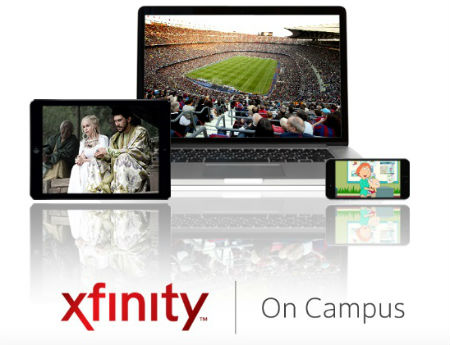Comcast Forges More Campus Connections

Comcast has signed on 27 schools for Xfinity on Campus, its IP-delivered live and on-demand video service for college students, and is adding some new bells and whistles to the platform for the new school year.
A year after Xfinity on Campus launched commercially with seven university partners on board, Comcast said the service will be available this fall at the following schools: Benedictine College; Brandeis University; Bridgewater College; Chico State; Dartmouth College; University of Delaware; Drexel University; Emerson College; Goucher University; Lasell College; Loyola University Maryland; Massachusetts Institute of Technology; Morehouse College; University of New Hampshire; Northwestern University; Regis College; Rider University, St. Michael’s College; Seattle Pacific University; Sonoma State University; Washington & Lee University; and Yale University.
The service is also being at Carnegie Mellon University this fall, and will be rolled out soon to Tennessee State University. Other announced partners include Oregon State University, Champlain College and Lebanon Valley College.
Comcast hopes to bring more schools to the Xfinity On Campus fold later this year, Marcien Jenckes, Comcast Cable’s executive vice president, consumer services, said in a media briefing. Those schools, he noted, need to meet certain technical requirements such as a robust WiFi network on campus.
Jenckes also talked about the strategic importance of Xfinity On Campus, which is powered by Comcast’s cloud-based, next gen X1 video platform.
Xfinity on Campus “allows us to introduce students to our next generation products, services and technologies,” Jenckes said. “Strategically, that was very important for us as we want to show the marketplace that we are evolving to satisfy consumer behavior.”
Comcast also shared some learnings, including some usage trends, it has seen with Xfinity on Campus, which is currently offered on campus WiFi networks on PC and laptop browsers and iOS and Android mobile devices.
Multichannel Newsletter
The smarter way to stay on top of the multichannel video marketplace. Sign up below.
Students primarily use their laptops to view content using Xfinity on Demand, explained Jeremy Andreoli, Comcast Cable’s executive director, video services.
Per Xfinity on Campus viewing data, millennial students watch live programming almost twice as much as VOD content – 62% versus 38%.
“If you give students access to live TV, they actually watch it,” Andreoli said.
Led by the NBA playoffs, sports programs have dominated live TV viewing on Xfinity on Campus, followed by Major League Baseball, the Stanley Cup playoffs, NBA games, ESPN’s SportsCenter, Premiere League soccer, and UEFA Champions League soccer matches.
HBO’s Game of Thrones was the most popular VOD title, followed by Keeping Up With the Kardashians (Bravo); Grey’s Anatomy (ABC), The Big Bang Theory (CBS) and Modern Family.
Andreoli said new components coming to Xfinity On Campus later this year include an option to add Comcast’s cloud DVR. In addition to allowing students to stream recorded shows while they are on campus they can also download recorded programs for later viewing on mobile devices.
Comcast is also transitioning Xfinity On Demand to a new consolidated version of the Xfinity TV app and Web site that will support live TV, on-demand and DVR viewing.
Students will also be able to purchase digital movies and TV shows through Comcast’s electronics sell-through platform.
Comcast has not yet committed to bring Xfinity on Campus to TV-connected devices such as Roku boxes and the Apple TV, but does have hybrid deals in place with university partners that also allow students to connect TVs directly to traditional set-top boxes.
“Our goal is to make sure that the end users can consume the content on their terms,” Jenckes said, noting that XoC could evolve to take advantage of Comcast’s “Xi” class of IP-based TV client devices that are used with X1 today.
Comcast, of course, isn’t the only provider that’s making multiscreen connections with university partners. Others include Philo, a startup that landed a $10 million “B” round of funding earlier this year, and Campus Televideo.
Jenckes said competition for such “middle service providers” arose when cable didn’t evolve fast enough to support changing student viewing behaviors.
“They historically filled holes in the marketplace,” he said. “The way I look at it, if we’re doing our job the way we should be doing our job and meeting our customer needs, there isn’t necessarily a need for that middle service.”
